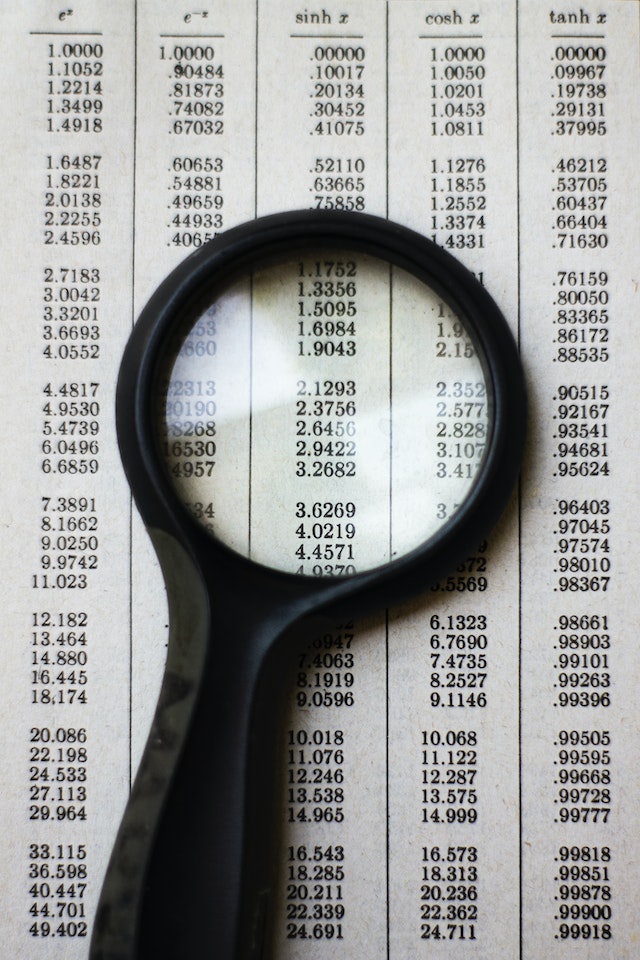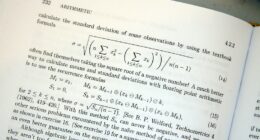Mathematical models provide a deterministic approach in which the relationships between variables are explained mathematically and thus can be used to predict outcomes with absolute certainty. Statistical models on the other hand rely on probability theory and sampling techniques to describe trends that are observed in data sets.
Mathematical Model
(Photo By Photo by Nothing Ahead)

A mathematical model is a tool that is used to describe a system or process. It is often used in the sciences, such as physics and biology, as well as in engineering and economics. A mathematical model can be used to predict the behaviour of a system, to understand how a system works, or to design new systems.
There are four main types of mathematical models: Deterministic, Stochastic, Dynamic, and Static.
Deterministic models are those in which a set of fixed parameters uniquely determine the outcome of the model. In other words, given a set of inputs or initial conditions, the output or subsequent condition is completely determined by the model. An example of this would be a simple linear equation such as y=mx+b.
Stochastic models are those in which some element of chance or randomness is present. This means that even if the same inputs or initial conditions are used, the output or subsequent condition will not always be the same. One example of this would be flipping a coin – each time you flip it there is a 50% chance it will land on heads or tails.
Dynamic models are those that describe the behavior of a system over time. It typically involves a set of variables that change or evolve according to a set of rules or equations. These variables might represent physical quantities, such as position, velocity, or mass, or they might represent abstract quantities, such as economic variables or population sizes.
Static models describe the relationships between variables at a particular point in time, without taking into account how these variables change over time.
Statistical Model
(Photo By Clay Banks on Unsplash)

A statistical model is a tool that is used to describe the relationships between variables. The variables can be anything that can be measured, such as age, income, weight, etc. The purpose of a statistical model is to help us understand how these variables are related and to make predictions about the population. Statistical models are often used in social sciences, such as sociology and psychology, as well as in medicine and biology. Statistical models can be used to predict the probability of an event occurring, to understand how two or more variables are related, or to design experiments.
There are two main types of statistical models: Linear and Nonlinear.
Linear models are the simplest type of statistical model, and they assume that the relationship between the variables is linear.
Nonlinear models are more complex, and they allow for more flexibility in the relationship between the variables.
Difference between Mathematical Model and Statistical Model
A mathematical model is a set of equations that describe a system. A statistical model is a set of probability distributions that describe a system. The two types of models are used to make different kinds of predictions.
Mathematical models are used to predict future states of a system, based on its current state. For example, a mathematical model of the motion of a planet can be used to predict its position at any future time. Statistical models are used to predict the likelihood of various events occurring, based on past data. For example, a statistical model of stock prices might be used to predict the likelihood of a stock price rising or falling over the next week.
What is the relationship between mathematics and statistics?
Mathematics is the study of numbers, shapes, and patterns. Statistics is the study of how to collect, analyze, and interpret data. Both disciplines use mathematical models to describe and predict outcomes.
The main difference between mathematical and statistical models is that mathematical models are more specific and concrete, while statistical models are more abstract and general. Statistical models often make assumptions about the underlying process that may not be valid in all situations. Mathematical models are based on actual data and are more likely to give accurate results.
Both mathematics and statistics are important tools for understanding the world around us. They can be used together to help us make better decisions based on data.
Why is mathematics and statistics important?
Mathematics is the language of science. It is the tool we use to describe and understand the physical world around us. Statistics is the study of data. It helps us to understand patterns in data and to make predictions about future events.
Both mathematics and statistics are important for solving real-world problems. Mathematics provides a way to model situations and to understand relationships between different variables. Statistics allows us to analyze data and to make inferences about population parameters.
How do you know what statistical model to use?
There is no one definitive answer to this question, as it depends on a number of factors specific to each individual data set and problem. However, there are a few general tips that can be useful in helping to choose the right statistical model.
One important consideration is the type of data you are working with. Different types of data require different types of models. For example, categorical data is typically modelled using logistic regression, while continuous data is usually modelled using linear regression.
Another important thing to consider is the purpose of the model. Different types of models are better suited for different purposes. For example, if you want to predict a future value based on past values, you will use a time series model. If you want to determine which variables are most important in predicting an outcome, you will use a multivariate regression model.
Finally, it is also important to consider the complexity of the model. More complex models can provide more accurate predictions but may be more difficult to interpret and understand. Simple models may be easier to interpret but may not be as accurate. The right balance will depend on your specific needs and preferences.
What are the characteristics of mathematical model?
There are many different types of mathematical models, but all share some common characteristics. Firstly, a mathematical model must be able to describe the relationships between the different elements in the system. Secondly, it must be able to handle uncertainty and unknowns. And finally, it must be mathematically tractable, meaning that it can be analysed using mathematical tools and methods.
What are the advantages of mathematical Modelling?
Mathematical modelling is the process of creating mathematical models to describe real-world phenomena. The advantages of mathematical modelling include the ability to:
1. Formalize relationships between variables: Mathematical models can help us to formalize relationships between variables, and to understand how changes in one variable may lead to changes in another.
2. Make predictions: By understanding the relationships between variables, we can use mathematical models to make predictions about real-world phenomena.
3. Test hypotheses: Mathematical models can be used to test hypotheses about relationships between variables. This can help us to identify which relationships are supported by data, and which are not.
4. Find hidden patterns: Mathematical models can sometimes uncover hidden patterns in data that would be difficult to find using other methods.
5. Simplify complex situations: By representing complex situations using mathematical models, we can often simplify them and gain a better understanding of what is going on.
What are the advantages of statistical Modelling?
Statistical modelling is a powerful tool that can be used to understand complex phenomena and make predictions. Some of the advantages of statistical modelling include:
1. The ability to handle complex data: Statistical models can deal with data that is too complex for traditional methods, such as regression analysis.
2. The ability to make accurate predictions: By understanding the relationships between variables, statistical models can be used to make accurate predictions about future events.
3. The ability to identify causal relationships: Statistical models can help identify cause-and-effect relationships, which can be useful in policymaking and decision-making.
4. The ability to improve decision-making: By understanding the risks and uncertainty associated with different decisions, statistical models can help decision-makers choose the best course of action.
5. The ability to communicate results: Statistical models can be used to communicate results clearly and concisely, making them accessible to a wide audience.
What are the limitations of mathematical models?
Mathematical models are limited in their ability to predict real-world outcomes. They are often too simplistic to be accurate, and they ignore many important factors that can affect the outcome of a decision. In addition, mathematical models can be very complex, making them difficult to understand and use.
What are the limitations of statistical models?
Statistical models are limited in a number of ways. First, they are only as good as the data that they are based on. If the data is of poor quality, the model will be as well. Second, statistical models make assumptions about the underlying distribution of the data. This can lead to problems if the assumptions are not met. Third, statistical models can be complex and difficult to understand. Finally, they can be sensitive to small changes in the data.
Featured Image By – Isaac Smith on Unsplash








